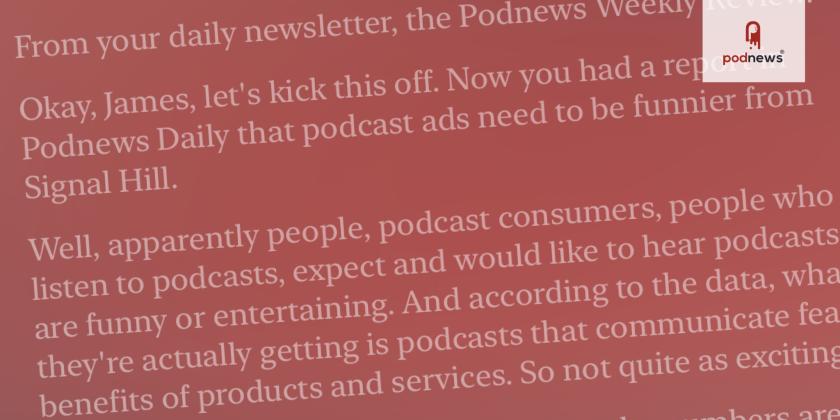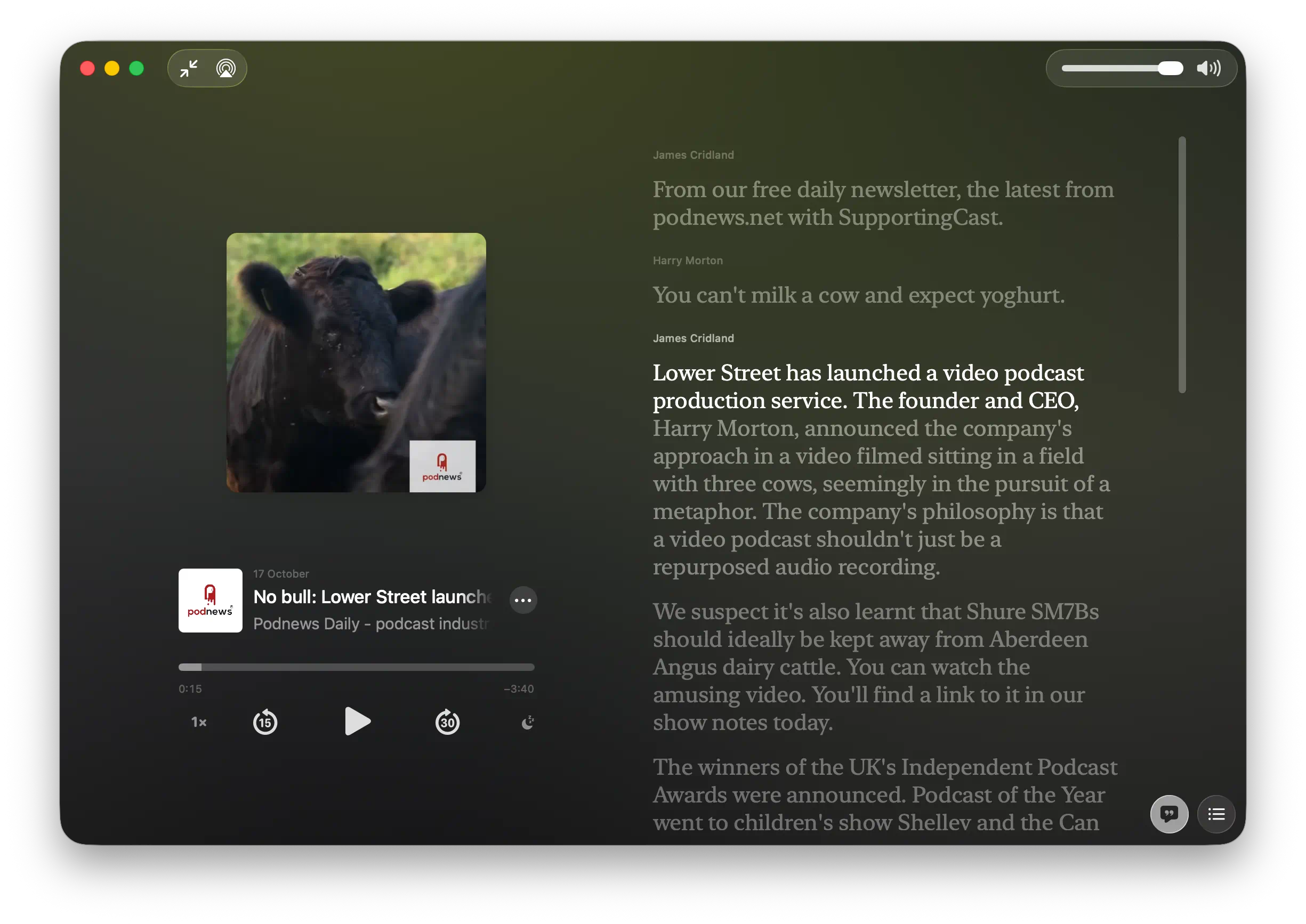
How do Apple Podcasts Transcripts work?

On Mar 5 2024, Apple Podcasts launched one of the biggest innovations in podcasting for some time - full transcripts for almost every podcast out there. Here’s a comprehensive article to answer any questions you might have.
Does Apple Podcasts have a fancy page showing this off?
Yes. Here it is.
Which podcasts get transcripts?
All new episodes in thirteen supported languages.
Apple has now completed producing transcripts for all older episodes, too. There’s more than 125 million of them!
How quickly are transcripts added?
They appear a while after the publication of a new episode. The website says: “For new episodes, make sure it’s been at least 24 hours since your episode was published.”
In our experience, automated transcripts appear at the same time as a new show appears. If you’re supplying an accompanying transcript via your RSS feed, that can take a little longer to be ingested.
Next…
Where do these transcripts appear?
You’ll see them in iOS 17.4 (and greater) on iPhone, and iPadOS 17.4 (and greater) on iPad.
Here’s how to update to the latest version of iOS or iPadOS.
There are two views of transcripts within Apple Podcasts on mobile: a simple one in the episode view, and when hitting the transcript button in the player, which highlights word-by-word and lets you touch the paragraph you’d like to hear.
And, as of October 2025, they also appear in the Podcasts app on your Mac, using iOS 26. This is what they look like there.

Are they highlighting word-by-word?
Yes - well, sentence by sentence in most cases. Apple matches up the transcript to the audio.
(We’d presume that this additional step will allow them to spot any podcaster who throws lots of spam in their transcription).
It also shows the existence of musical interludes as you listen, with the use of a little three-dot pause symbol. As you might expect, it’s a very similar experience to Apple Music’s lyrics, and Apple Books.
Can you see chapter titles in the transcript view?
Yes, you can.
Can you see images from chapter titles in the transcript view?
Yes, as you listen. They appear at the top of the screen. Here’s the Podnews Weekly Review inside a chapter with an image.
Does it show speaker names?
Not for Apple’s auto-transcripts (because they don’t know who’s speaking).
But, if you supply your own transcripts - see below - and mark them up correctly, then it does show speaker names - both for VTT and SRT transcripts. Again, here’s the Podnews Weekly Review.
Can I use the transcripts to find parts of podcasts I’m interested in?
Absolutely you can. There’s a search button in both views on iPhone, allowing you to search the full transcript. On MacOS it’s a little harder - use the ellipsis button next to the episode title to “View transcript”, where you’ll see the older view with a search button.
You can also touch a part of the transcript to get the player to go to that part of the podcast. Hold it, or right-click it on desktop, for more options including the possibility of sharing from that point.
Can I copy/paste the transcripts?
You can highlight a short paragraph to send to someone else, yes. While the app will let you highlight the entire script, it won’t let you copy more than a few paragraphs, though.
Do I have to download the podcast’s audio to read the transcript?
No.
How does this work with dynamically-inserted ads?
We listened to an episode of The Daily from the New York Times. Our version had an ad for the Queensland Government at the start, telling us to wear sunscreen. This portion of the podcast did not have a transcript at all: but we also didn’t see a transcript of what listeners in the US got either.
Apple says: “If portions of your episode change with dynamically inserted audio, Apple Podcasts will not display the segments of the audio that have changed since the original transcription.”
As a creator, do I have to use Apple’s auto-transcripts?
No. You can opt-in to a feature that lets you use your own transcripts. They use the standard podcast:transcript tag from the Podcasting 2.0 project.
First, opt-in to using your own transcripts in Apple Podcasts Connect; then, ensure you’re linking to either VTT (or an SRT fallback) in your RSS feed.
Can I turn transcripts off altogether for my podcast?
You can. It’s a super-hidden setting, but you’d go in Apple Podcasts to your podcast, go to the episode, choose “Free RSS” under Audio & Transcripts, hit the “EDIT” button at the bottom of the dialog box, choose “use a custom setting”, and in the drop-down box, choose “Do not display transcripts for this episode”.
It’s bad to do this because you’re communicating that you don’t care about accessibility; it might be illegal in your country; and listeners can just turn auto-captions on using their mobile phone anyway. We’d suggest you didn’t do that.
Which podcast hosting companies support transcripts?
Apple has a list, though there are more.
Can I edit Apple’s auto-transcripts?
No. But you can download the auto-transcript, and use that to edit a corrected version if your podcast host supports the transcript feature; or edit it directly on your podcast host.
What’s the typeface they’re using?
What a geeky question. It’s one of the fonts designed for Apple Books: we think it’s New York. Well done you.
More seriously, we understand that the podcasts team spent considerable time with the accessibility specialists at Apple, ensuring that everything from the font choice to the colour contrast works properly.
Can I download Apple’s auto-transcripts?
As a content creator? Yes, as a VTT file. You can do this from Apple Podcasts Connect - go to an episode, look at “Audio and Transcripts”, and click the Free RSS box. That will then give you a dialog box to let you view the auto-generated transcript and allow you to download it.
As a listener? Not as a VTT file, but you can highlight the transcript in the Apple Podcasts app, and copy/paste portions over (but not the whole thing).
Automatically? The URL has one opaque v4 RFC4122-type GUID, and one v5 GUID that is related to the episode, as well as Apple’s proprietary episode ID, and uses an account token, so no, you’re not automatically downloading this file as far as we can tell.
Where is the Apple’s specification for the VTT file or the tag?
They really don’t say much, but it’s here.
An Apple-generated VTT file for one of our daily podcasts is here for you to download. There are a few different voices in here.
Why VTT?
VTT also works with HTML’s AUDIO tag.
Is there a VTT validator?
Sure - here’s one. Apple’s downloadable file validates correctly.
The WebVTT specification is here on the W3C website.
How can I make a VTT file?
If your podcast host wants a VTT file, then you can make one using an audio editor like Hindenburg Pro (right-click in manuscript view, and export as VTT).
Or you can use something like Whisper on your Mac to make one. Here are lots of instructions to install it.
There are also VTT file editors available online. We quite like Spreaker’s free podcast transcription website, which is also available as a desktop app.
You can even open a VTT file in a text editor to make simple edits (like correcting spelling of names).
I upload my podcast to YouTube. Can I get a VTT file from YouTube?
Absolutely, you can. Here’s how:
- Go to https://studio.youtube.com
- Click “subtitles” in the left-hand menu
- Click the episode you want the subtitles for
- You’ll see an entry for “English (automated captions)”. Hold your mouse over the “Published” text and you’ll see three icons - an edit icon, a trashbin icon, and a three-dot menu.
- Click the three-dot menu and choose “Download”
- …and finally, choose .vtt
Does Apple make auto-transcripts for private podcasts?
No, they don’t. But Jason Snell says that if you produce transcripts in the RSS feed, those will show.
Can we show transcripts using WebVTT in a web player?
Sure you can. It’s a standard, too.
Our Editor has much too much time on his hands and has written this. There’s a gotcha with Safari desktop, which he thinks he’s got past.
Where is more information about the podcast:transcript feature and its support?
We’d recommend a look at this page on the Podcasting 2.0 website, and these notes on implementation.
































































































